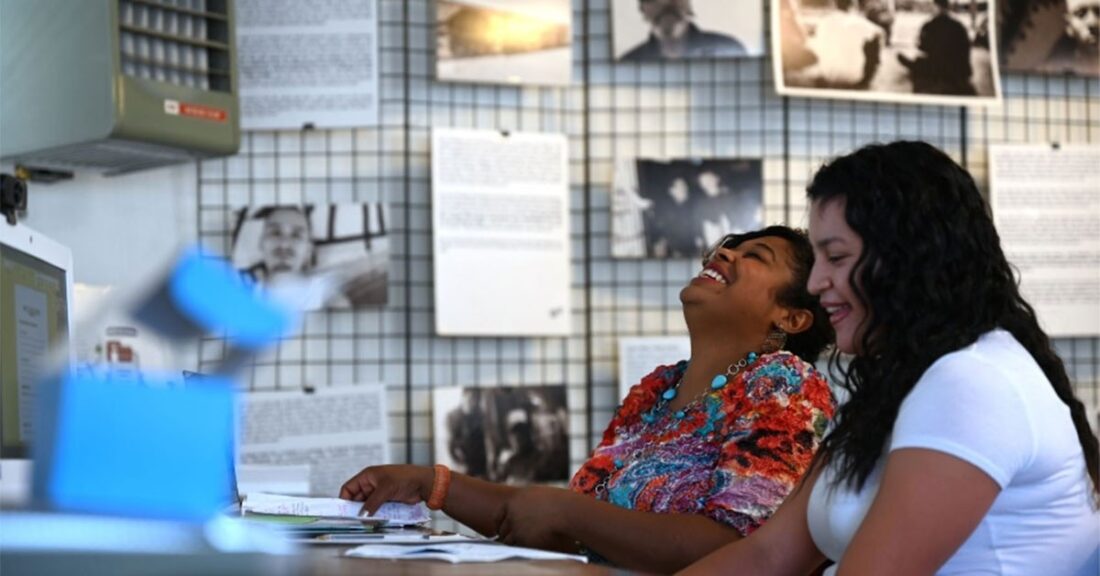Collaborating for Youth Justice in Albuquerque

From left: Teresa Garcia and B. MonTeil Williams facilitate a workshop for members of the Albuquerque Justice for Youth Community Collaborative in June 2021. Photo credit: Jaelyn deMaria.
A new report documents the first year of an ambitious, long-term effort in Albuquerque, New Mexico, to reduce and eventually eliminate dependence on the juvenile justice system and to build a culturally grounded alternative that keeps youth out of institutions, and instead “safe and supported by the capable hands of their own communities.”
Established in January 2021 with funding from the Annie E. Casey Foundation, the Albuquerque Justice for Youth Community Collaborative is made up of local grassroots organizations, youth justice advocates and young people and families who have been directly affected by the juvenile justice system. Eighty percent of the collaborative’s members are people of color, and approximately one-third are younger than age 21 — with more than 50% having direct experience in the criminal or youth justice system.
“For many years, we have worked primarily with courts and probation departments — precisely because those institutions have enormous power to affect the freedom and opportunities afforded to young people,” says Danielle J. Lipow, senior associate in the Foundation’s Juvenile Justice Strategy Group. “But we weren’t seeing things through the eyes of the young people and communities who had the most system contact and, in many cases, bore the brunt of over-policing, surveillance and mass incarceration. We were missing their insight, creativity and wisdom, which became an untenable omission when we acknowledged our own limited perspective.”
Strengthening Connections
Albino Garcia, executive director of the La Plazita Institute in Albuquerque and founder of the collaborative, designed its cultural framework: Quinto Sol, or Five Suns, a model rooted in Aztec creation stories he has successfully used in his work with young people.
“I’ve always thought that the phrase, ‘We’re stronger together’ stands,” says member Khadijah Bottom, founder of VIZIONZ-SANKOFA. “This collaborative exemplifies it.”
Going deep into history to understand the roots of juvenile justice inequities and the alternatives to incarceration, collaborative members have shared their own stories and experiences and offered solutions for youth and families involved with the legal system. “If the community’s involved and the youth see that people care, they respond to that,” says a collaborative member in the report.
Participatory Documentation
The framework for the collaborative’s comprehensive documentation effort has four elements:
- oral histories of collaborative members;
- an “inside-out” perspective that recognizes the expertise and knowledge of those who have experienced incarceration;
- modern, traditional and ancient forms of storytelling, including artistic and creative forms of media; and
- solutions-oriented journalism focusing not only on what may, or may not, be working for youth but also on the how and why.

Funding for the participatory documentation team includes stipends for young people and others connected with the collaborative.
Next Steps
At the end of 2021, the collaborative formed “engagement circles,” or workgroups, that are making action plans in several areas, including policy and legislative change. To amplify the community’s voice in defining challenges and crafting solutions, the collaborative is building bridges between its members and traditional decision-makers across New Mexico and seeking state funding to develop a community-driven and community-based continuum of direct services and opportunities for young people.
Lipow sees the Foundation’s investment in the collaborative paying off at multiple levels: for individual members, for New Mexico’s youth justice system and for the field more broadly. “The Foundation has already learned so much from the collaborative, and those lessons are strengthening and deepening our work all over the country,” she says. “First and foremost, we have learned that it is easy to talk about sharing power, shifting resources and prioritizing youth leadership. It is immeasurably more difficult to practice the humility required to put those values into action.”






